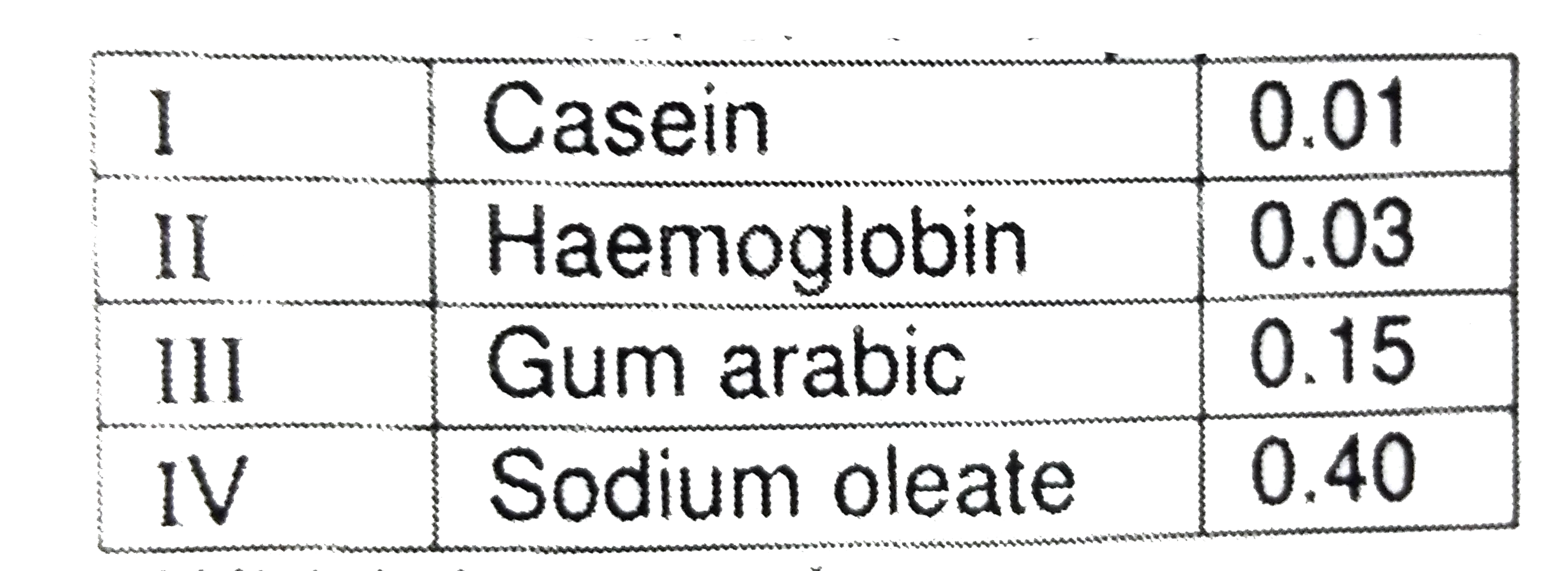the protective power of the lyophilic colloids es expressed in terms of gold number, a term introduced by Zsigmondy. Gold number is the number of milli - gram of the protective colloid which prevent the coagulation of 10 mLof red gold sol , when 1 mL of a 10 per cent solution of sodium chloride is added to it . thus smaller the gold number of lyophillic colloid, the greater is the protective power.
gold number given an indication of
protective nature of colloids
purity of gold in suspension
the charge on a colloidal soultion of gold
gram of gold per litre of soultion
The correct Answer is:a
To solve the question regarding the gold number and its significance in terms of the protective power of lyophilic colloids, we can break down the explanation step by step:
1. Understanding Gold Number:
- The gold number is defined as the amount (in milligrams) of a protective colloid required to prevent the coagulation of 10 mL of a red gold sol when 1 mL of a 10% sodium chloride solution is added.
- This definition indicates that the gold number quantifies the effectiveness of a protective colloid in stabilizing a colloidal system.
Hint: Recall that the gold number is a measure of how much protective colloid is needed to maintain stability against coagulation.
2. Protective Power of Lyophilic Colloids:
- Lyophilic colloids have a high protective power, which means they can effectively prevent the aggregation of particles in a colloid.
- The smaller the gold number, the greater the protective power of the colloid. This means that less protective colloid is needed to prevent coagulation.
Hint: Remember that a lower gold number indicates a more effective protective colloid.
3. Coagulation and Aggregation:
- Coagulation refers to the process where colloidal particles aggregate and lose their stability in the dispersion medium.
- Protective colloids help to stabilize the system by preventing this aggregation, thus maintaining the colloidal state.
Hint: Think about how protective colloids act as a barrier to prevent particles from coming together and forming larger aggregates.
4. Conclusion about Gold Number:
- The gold number serves as an indication of the protective nature of colloids. It tells us how effective a colloid is in preventing coagulation.
- Other options mentioned (purity of gold, charge on colloid solution, grams of gold per liter) do not relate to the protective nature of colloids and are therefore incorrect.
Hint: Focus on the relationship between the gold number and the protective ability of colloids to determine its significance.
Final Answer:
The gold number indicates the protective nature of colloids, specifically how effectively a protective colloid can prevent the coagulation of a colloidal system. A smaller gold number signifies greater protective power.
- The gold number is defined as the amount (in milligrams) of a protective colloid required to prevent the coagulation of 10 mL of a red gold sol when 1 mL of a 10% sodium chloride solution is added.
- This definition indicates that the gold number quantifies the effectiveness of a protective colloid in stabilizing a colloidal system.
- Lyophilic colloids have a high protective power, which means they can effectively prevent the aggregation of particles in a colloid.
- The smaller the gold number, the greater the protective power of the colloid. This means that less protective colloid is needed to prevent coagulation.
- Coagulation refers to the process where colloidal particles aggregate and lose their stability in the dispersion medium.
- Protective colloids help to stabilize the system by preventing this aggregation, thus maintaining the colloidal state.
- The gold number serves as an indication of the protective nature of colloids. It tells us how effective a colloid is in preventing coagulation.
- Other options mentioned (purity of gold, charge on colloid solution, grams of gold per liter) do not relate to the protective nature of colloids and are therefore incorrect.
The gold number indicates the protective nature of colloids, specifically how effectively a protective colloid can prevent the coagulation of a colloidal system. A smaller gold number signifies greater protective power.
Similar Questions
the protective power of the lyophilic colloids es expressed in terms of gold number, a term introduced by Zsigmondy. Gold number is the number of milli - gram of the protective colloid which prevent the coagulation of 10 mLof red gold sol , when 1 mL of a 10 per cent solution of sodium chloride is added to it . thus smaller the gold number of lyophillic colloid, the greater is the protective power.
On addition of one mL of sloution of 10 % NaCl to 10 mL. of red gold sol in presence of 0.025 g of starch the coagultion is just prevented . the gold number of starch is
View Solutionthe protective power of the lyophilic colloids es expressed in terms of gold number, a term introduced by Zsigmondy. Gold number is the number of milli - gram of the protective colloid which prevent the coagulation of 10 mLof red gold sol , when 1 mL of a 10 per cent solution of sodium chloride is added to it . thus smaller the gold number of lyophillic colloid, the greater is the protective power.
which of the following statement (S) is / are correct?
View SolutionGold number is:
View SolutionThe protecting power of lyophilic colloidal solution is expressed in terms of
View SolutionGold number gives
View SolutionGold number is a measure of
View SolutionGreater is the protective power of lyophilic colloid
View SolutionDefine Gold number.
View SolutionGold number of some lyophilic sols are :

Which has maximum protective power :
View SolutionStatement-1:Gold number is the measure of protective powers of different colloids.
Statement-2: The smaller the gold number of lyophilic colloid, the smaller is its protective power.
View Solution
